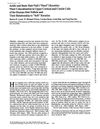TLDR Scientists discovered two versions of a new human hair keratin gene.
The study identified a novel human type I hair keratin gene, hHa3, which was found to have two isoforms, hHa3-I and hHa3-II. This discovery was based on nucleotide and amino acid sequence analysis, revealing differences in 24 amino acid positions compared to a previously described hHa3 keratin. The research involved PCR amplification of genomic DNA from 25 normal human subjects, resulting in two distinct products due to unique intron 6 sequences, indicating separate genes for each keratin species. Southern blot analyses confirmed that both keratin genes are present as single copy sequences in the human genome. This work provided evidence for the existence of two distinct isoforms of the hHa3 keratin gene.
47 citations
,
June 1994 in “Experimental Cell Research” mHa2 and mHa3 keratins have different structures and roles in mouse hair and tongue tissues.
40 citations
,
February 1994 in “Journal of Investigative Dermatology” 18 citations
,
February 1992 in “Molecular Biology Reports” A specific type II hair keratin was identified and found in hair cortex and tongue cells.
65 citations
,
February 1992 in “Development” Type II keratin genes are crucial for hair follicle differentiation and have a conserved structure and expression pattern.
21 citations
,
December 1991 in “Annals of the New York Academy of Sciences” Most mouse hair keratin genes are on chromosomes 11 and 15.
27 citations
,
November 1991 in “Journal of Investigative Dermatology” 25 citations
,
August 1991 in “Journal of Investigative Dermatology” 51 citations
,
March 1990 in “Journal of Investigative Dermatology” 41 citations
,
December 1988 in “Journal of Investigative Dermatology” 187 citations
,
May 1988 in “Differentiation” Trichocytic cytokeratins are found in hair, nails, tongue, and thymus cells, showing complex regulation in tissue development.
248 citations
,
April 1988 in “Differentiation” Human and bovine hair follicles have distinct cytokeratins specific to hair-forming cells.
 356 citations
,
December 1986 in “The journal of cell biology/The Journal of cell biology”
356 citations
,
December 1986 in “The journal of cell biology/The Journal of cell biology” Hair and nail cells share similar proteins, indicating a common differentiation pathway.
198 citations
,
October 1986 in “Differentiation” 45 citations
,
January 1986
238 citations
,
May 1989 in “Journal of Investigative Dermatology”
